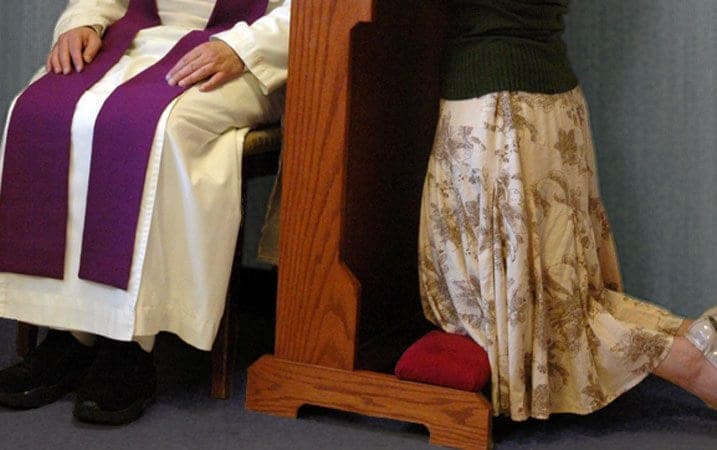SYDNEY, Australia – Great shocks to the system often can jar loose utterly new responses from institutions typically given to maintaining the status quo. Other times, the effect can be to reopen debates from the past which, not so long ago, seemed definitively closed.
That latter scenario may be unfolding in Australia right now, pivoting on once-intense debates over the so-called “Third Rite” of confession, meaning a form of the sacrament celebrated in group form rather than individually.
The Catholic Church in Australia has been living through such a great shock for at least the last five years, after a government-led Royal Commission into Institutional Responses to Child Sexual Abuse was established, which took an especially close look at the Church and its failures. In the end the commission issued 189 recommendations for reform, including 80 that are specific to the Church.
While the Australian bishops on August 31 said “yes” to some 98 percent of those recommendations, it was their one “no” that’s produced an avalanche of outrage and commentary Down Under – their refusal to erode the seal of the confessional to require confessors to report admissions of child abuse to civil authorities.
Recently, the Labor-led government of the Australian state of Victoria announced it would overhaul existing law to mandate that priests who learn about child abuse in the confessional and fail to report it to the police will face up to three years in prison.
“The safety of children is our highest priority and our biggest responsibility — people in religious ministry are not exempt from this,” said Victoria’s Minister for Children Jenny Mikakos.
In the tempest that’s followed, some progressive-minded Aussie Catholics with long memories are suggesting that had their bishops not caved into the Vatican two decades ago over the “third rite,” we wouldn’t be having this conversation.
In general, the Church recognizes three forms the sacrament of confession, or reconciliation, can take:
- Individual confession, where the penintent approaches a priest individually, confesses his or her sins, and is absolved.
- A community gathering featuring an opening hymn, a greeting by the priest, and a prayer. The priest allows a brief time of personal reflection after the homily. Then each person confesses to a priest individually and receives absolution.
- A service in which there is no individual confession. The priest gives a general absolution of sins after the community have reflected privately and said a prayer expressing their repentance.
That “third rite” theoretically is only supposed to be used in emergency situations, such as soldiers heading off into battle or a disaster with eminent threat of death. (Think the deck of the Titanic.)
In Australia in the period after the Second Vatican Council, however, the third rite became widespread, in part as a pastoral response to rural areas where there simply weren’t enough priests to offer individual confessions on a regular basis. In part, too, it was justified by post-Vatican II understandings that sin isn’t just individual but also collective and structural. It was seen as a more effective way, for instance, of doing penance for the mistreatment of the country’s aboriginal people.
In the late 1990s, the Vatican clamped down aggressively on the use of third rite in Australia, which was part of a wider thrust back to more traditional modes of worship and sacramental practice known as the “Liturgy Wars” in the late Pope John Paul II years.
The rollback in Australia caused wide protest, but over time the third rite gradually became less and less common.
Now, however, some Australian Catholics who agree with the Royal Commission that there should be no space in the Church where a veil of secrecy applies to child abuse are floating the idea of bringing back the third rite.
I spoke to a veteran religious sister in Melbourne on Thursday, for instance, who told me that “if the Vatican had just left us alone, we wouldn’t be in this mess.”
Whatever the merits of that argument, it doesn’t cut much ice with Archbishop Anthony Fisher of Sydney, who’s the closest thing to a national leader the Church in Australia has. Overall he’s taken a tough line on the abuse scandals, demanding that the Church be committed to a policy of “no excuses, no cover-ups.”
A Dominican who still wears the white habit of the Order of Preachers as archbishop, Fisher sees the conversation about the third rite as a non-starter.
“Some of the people who have more or less accepted this recommendation from the Royal Commission, that we abolish the seal of confession, are saying that we would have never had this problem if we’d kept the third rite because people wouldn’t actually be confessing their sins, just their ‘sinfulness’,” he told Crux in a Sept. 7 interview at his residence in Sydney.
“Then, everyone would be given an absolution together,” he said.
“In fact, of course, we know that even when the third rite was practiced more commonly, if you were aware of serious sin you still had to go and make a regular confession. It doesn’t address that at all,” Fisher said.
At bottom, Fisher said, the push for the third rite is often a smokescreen for avoiding confession altogether.
“In fact, what people really want is a fourth rite of confession, which is to forgive yourself and not have to go to the confession thing at all,” he said. “That’s what they’re really asking for, and the third rite is a bit of a cover for that I think.”
Going forward, Fisher signaled a policy of “no retreat” on defending the seal.
“For those who do care about the sacrament of mercy, I think for the state to be proposing to interfere in this way and to start effectively bugging confessionals by requiring confessors to repeat what they’ve heard is really an attack on their ability to practice this faith,” he said.
“I’d say that is a very bad precedent for this country, and I think there are many other countries that would immediately recognize that it’s a step too far,” he said.
In general, Fisher says the debate over the seal of the confessional is a “huge red herring.” (He actually used the Aussie lingo “furphy,” which turns out to be the name of a company that made water carts for Australian troops fighting overseas, which became the gathering points of choice to swap rumors, innuendo, and urban legends.)
“If you knew what had been said in every confession in history, you’d be no closer to solving the child abuse crisis,” Fisher said.
First of all, he argued, predators almost never confess their crimes, because one aspect of their pathology is the ability to convince themselves they’re not doing anything wrong. By eroding the seal of the confessional, Fisher argued, all you’d be doing is depriving clergy of that rare opportunity to encourage a predator who does confess to turn himself in, or to encourage the rare victim to come forward who may confess under the illusion that the abuse is their fault.
The bottom line from Down Under seems to be this: Even if the shock of the abuse scandals and the Royal Commission have revived the third rite debate, under present management it likely doesn’t have any better chance of getting a green light than it did two decades ago.















